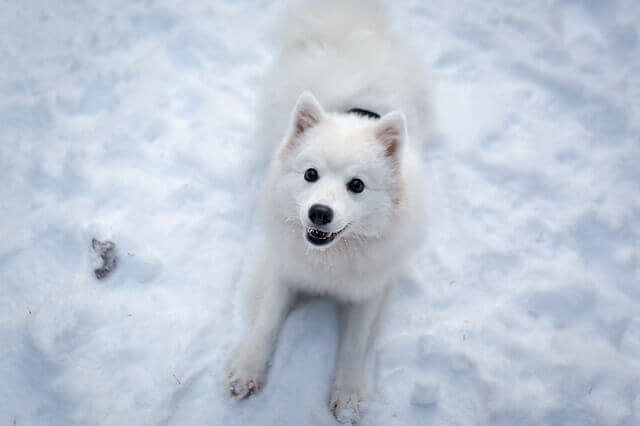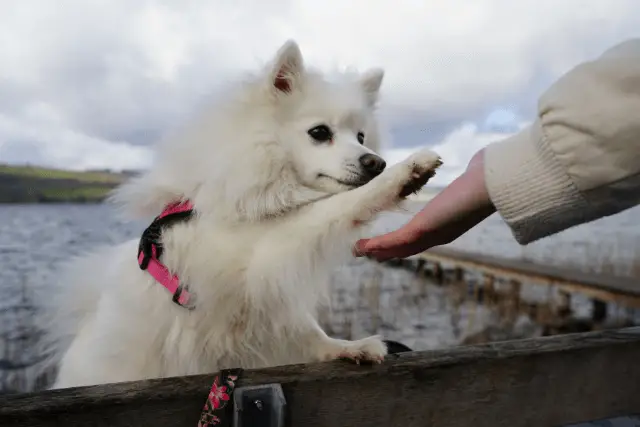Japanese Spitz
The Japanese Spitz is a dog breed that belongs to the Spitz family. It is a relatively small dog breed often mistaken for a small Samoyed or even a large white Pomeranian. This dog breed is not the oldest, but its popularity is certainly on the rise.
The Japanese Spitz is a friendly dog that will make a great companion and watchdog to anyone that decides to get one.

Height:
12-15 in (30-38 cm)

Weight:
10-25 lb (5-11 kg)

Origin:
Japan

Life Expectancy:
12-14 years
Dog Breed Characteristics
The Japanese Spitz is a good-looking dog. They have a certain appeal to all those who love small, fluffy dogs that can live in different conditions. These dogs have a pointed muzzle and triangular, pricked ears. Their nose is round, small, and black.
The Japanese Spitz has almond-shaped eyes that are set slightly oblique. They have a wide chest compared to their size, and their tummy is tucked in.

Japanese Spitz coat and care
One of the most impressive characteristics the Japanese Spitz have is their coat. Their coat is incredibly soft and fluffy, which makes them great cuddling buddies. Like every other Nordic breed, they have a thick double coat with a longer, softer outercoat and a soft, wooly undercoat.
The only color these dogs are allowed to come in is pure white. There should be no traces of other colors. The appearance of other colors is considered a substantial fault, and such dogs are not allowed to breed and will get disqualified from confirmation.
Having such a fluffy dog with such a luscious coat means having to take good care of it to keep it looking its best. That said, the Japanese Spitz has fewer grooming needs than other Spitz-type dogs. Their coats are thick and dry, which means they shouldn’t be washed too often.
They need to be regularly brushed, and doing it twice a week will do the trick. A great thing about their coat is that it naturally repels most of the dirt, and these dogs like to be clean.
Like any other dog breed, they require different care aspects, including trimming their nails and brushing their teeth. These two aspects of care are often overlooked but are very important to keep your pup in their best health. Brushing their teeth will prevent tartar build-up and prevent periodontal disease.

Trimming their nails will help the Japanese Spitz keep their healthy posture and keep their paws healthy. If you are unsure about how to trim your dog’s nails, check out this article, and you can find out everything you need to know about dog toothbrushes - here.
Temperament
If you are looking for a dog, their temperament should be high on your list. Luckily, the temperament of the Japanese Spitz is a friendly and affectionate one. They love family life and thrive on affection and company. They hate being left alone and can develop separation anxiety if they are left alone too long and too often.
These dogs might be smaller in size, but what they lack in size, they make up for courage and bravery. The Japanese Spitz makes an excellent watchdog that will alert you about close, suspicious activities. They make great playing companions to children, and their smaller size makes them relatively safe during play.
They don’t play aggressively, so you don’t need to worry about them accidentally harming kids. The Japanese Spitz is great with other pets, but make sure that they are properly socialized.
Training a Japanese Spitz
To have the best dog possible, your dog should be worked with. That means that you should invest time and train your Japanese Spitz. These dogs are naturally very loyal and intelligent, a combination that goes well with training. They can learn things rather quickly if you teach them using proper techniques.
Ensure that training sessions are not too long and that your dog gets rewarded for doing what is asked of him. Playful and reward-based training will be excellent for these dogs.

General health
The Japanese Spitz might be a young breed, but they were carefully studied and tested. It is a healthy breed with no significant health concerns and problems, but they are prone to some potential issues like any other dog breed. Those problems are;
- Patellar Luxation
- Skin conditions
- Eye problems
It is a rather small list, which makes them even more desirable. Make sure that you get your dog checked out regularly and don’t miss vet appointments.
If you are looking for a vet near you, check out this map with convenient vet locations and emergency animal hospitals. It is always best to be prepared!

Japanese Spitz breeders
No matter what breed you go for, getting a dog from a good breeder is one of the best things you can do for yourself and your future puppy. There are many concerns when buying from an unregistered breeder, and to find out more about that, check out this article.
Make sure that you find a good Japanese Spitz breeder that can answer all your questions about this breed. Ask them about life with these dogs and allow them to help you make an informed decision. A good and reputable breeder will be glad that their dog is going to a knowledgeable and careful owner.
SEARCH JAPANESE SPITZ BREEDERS
World Dog Finder team

Updated at31.08.2023.
Breed History
The Japanese Spitz’ history started in the 1910s when Japanese dog owners and breeders imported several German Spitz to Japan. Those dogs became very popular, and the Japanese decided to create their companion Spitz breed. They started importing other Nordic breeds and adding it to the developing Japanese Spitz breed.
After the Second World War, the breed’s standard was finalized, and the breed was fully developed. Breeders started exporting their dogs to Asia, Australia, Europe, and America, and these lovely white dogs began gaining popularity.

Different associations quickly recognized them, but to this day, they remain unrecognized by the AKC due to their similar appearance to the American Eskimo Dog.















Share